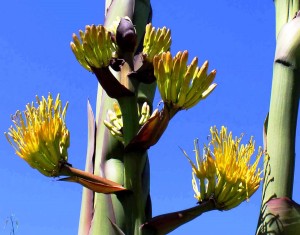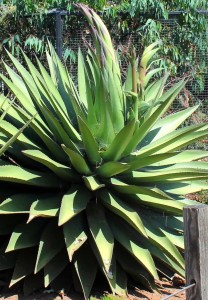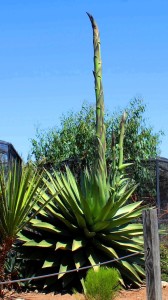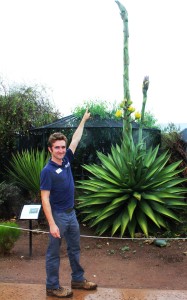Shaw’s Agave at the Living Coast about to burst into color
 You will not want to miss the color show that is about to happen at the Living Coast. One of our Shaw’s agave plants is about to burst into color. Why is this so exciting?
You will not want to miss the color show that is about to happen at the Living Coast. One of our Shaw’s agave plants is about to burst into color. Why is this so exciting?
Besides the spectacular color, these plants only bloom once in their lifetime after about 30 years. Additionally, Shaw’s agave is an extremely rare, endangered California plant. Watching this plant bloom is a special treat that may not always be available.
Coastal plants that take a long time to mature have difficulty keeping up with development. By some estimates, there might only be a single Shaw’s agave growing in the wild. The plants we have at the Living Coast are clones of that wild specimen, located near Border Field State Park and the Tijuana Estuary. Plants like Shaw’s agave send out identical plant shoots (or clones), known as pups, that can be removed from the host plant and replanted elsewhere.


One of the most spectacular things about this soon-to-bloom agave is how much it has grown in such a short time. We took our first in a series of pictures (to document this momentous blooming event) on August 3rd and, by August 16th, it had grown nearly 20 feet! But there’s more to come!
After reaching this height, the cactus began flowering. It will continue for a number of days and we’re sure the result will be even more spectacular than its twenty-foot growth spurt. If you want to see a once-in-a-lifetime blooming event, we recommend coming to the Living Coast — and soon!
We have taken photos of this blooming cactus every day and put them together in a time-lapse sequence so you can see just how much this plant has grown from August 3-September 9, 2015. The video, which you can see below, offers a preview of the blooms to come. We hope you come to enjoy the finale at the Living Coast very soon!
 Mark Valen, our Facilities and Horticulture Manager, contributed to this blog post. He says if the blooms get pollinated, then fruit will appear, containing seeds. Mark plans to sow the seeds around grounds, to sprout some of them in our greenhouse, and leave many of them to fall naturally and propagate themselves.
Mark Valen, our Facilities and Horticulture Manager, contributed to this blog post. He says if the blooms get pollinated, then fruit will appear, containing seeds. Mark plans to sow the seeds around grounds, to sprout some of them in our greenhouse, and leave many of them to fall naturally and propagate themselves.
This spectacular blooming event represents the end of this particular agave’s life cycle, but with a little luck and hard work we may be able to help the species’ continued survival. There are many other Shaw’s agave plants at the Living Coast — one of which is also going to bloom soon — so if you ever needed a reason to see some very rare coastal plants doing some very beautiful things, the time is now!
